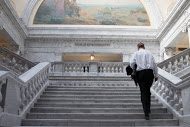By Aaron Hastings
Capital West News
SALT LAKE CITY – The high cost infrastructure bill for rural Utah, SB216, has passed through both the Senate and House floors, with favorable approval from both. Upon approval from Gov. Gary Herbert, the bill will become state law in Utah.
SB216 was designed as an incentive for businesses to move to rural parts of Utah, giving them a 30 percent tax credit against their costs to build infrastructure for utilities like water, power, gas, and transportation.
“We think this can be a real game changer for certain parts of the state and certain types of businesses,” said Sen. Ralph Okerlund, R-Monroe.

Okerlund presented the bill to the House Public Utilities and Technology Committee on Monday, March 9. Joining Okerlund was Steve Styler, co-chair of the Utah governor’s rural partnership board.
“We’ve understood for quite a long time that one of the biggest, if not the biggest, burden to entry for these businesses in rural Utah has been the cost of utility infrastructure,” Styler said, “frequently we are seeing businesses with power and gas bills that exceed 20 or 30 million dollars just to get into operation.”
Styler believes that after initial businesses have built utilities in rural areas, more businesses will come to the areas at a greater rate.
“What we’ve found is that when these businesses have been able to be located there, and they’ve provided utility infrastructure costs, there is a multiplier effect,” Styler said, “other businesses look at those areas where that infrastructure is in place.”
Both Okerlund and Styler assured the committee that the tax credits would only be awarded to companies after they had built the utility infrastructure and moved into the community.
Mark Compton of the Utah mining association and Lee Peacock, president of the Utah petroleum association, also attended to show support for the bill, echoing Okerlund’s sentiment that this bill is a “game changer.”
“Having this investment infrastructure development incentive in place can make the difference between whether or not a company chooses to invest their capital in Utah,” Compton said.
“The petroleum industry in this state is very supportive of this bill,” said Peacock, “we view this bill as a possible mechanism to incentivize the state’s petroleum refineries to actually implement and construct the infrastructure for the tier-three gasoline program here in Utah.”
The tier-three program, as laid out by the EPA, is an initiative to reduce air pollution by reducing sulfur in gasoline, increasing air quality, an important issue in Utah. Moving newer, cleaner refineries to Utah would help petroleum companies comply with the tier-three program on average, and simultaneously help economic growth in Utah.
“I don’t want to leave you with the impression that all of the refineries would actually make those investments here,” said Peacock, “this would simply be an incentive that would attract that capital here versus somewhere else.”
One of the committee’s concerns involved the EDTIF tax credit, a similar post production tax credit already in place in Utah. Styler outlined the key difference in response to the concern.
“Under the EDTIF, the real item that provides the greatest incentive is job creation,” Styler said, “this is more structured to the investment of capital, rather than having that emphasis placed on job creation.”




